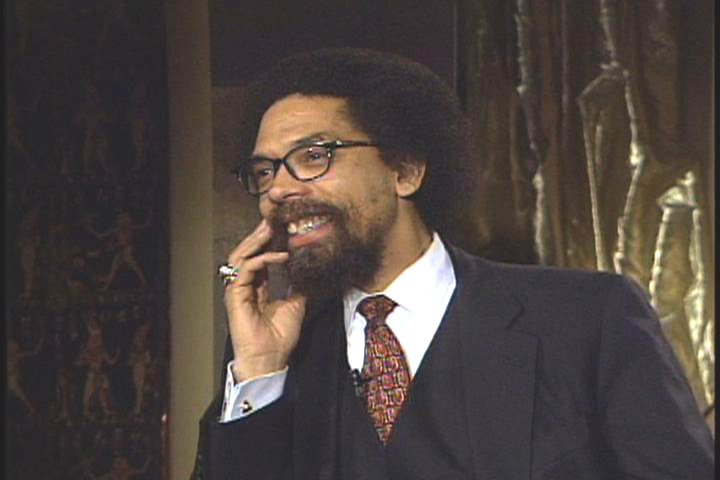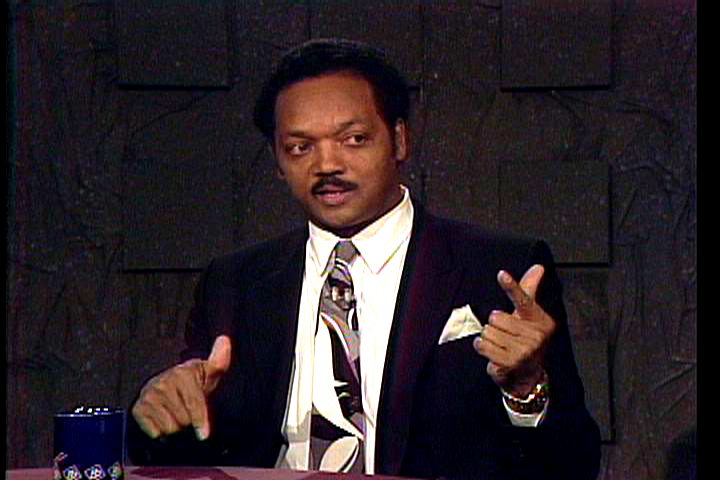Educational resources for:
Education and Families
Overview
De facto segregation persisted to varying degrees throughout the period covered by ABJ, even as landmark court decisions removed the legal props to the system. ABJ shows illustrate the black community's unwavering commitment to education as the pathway from poverty to prosperity and social justice. They examine the struggles over policy, access, curriculum, and resources at the heart of the black community's efforts to revitalize public education and infuse it with values drawn from neighborhood, church, and family.
Featured Show Clips & Comprehension Questions
Questions:
How does "Joe" explain the violence and the involvement of young teens in violent activity?
See Full Video

"Joe" discusses teen gun violence

Able Ulmer reports on New York City teachers strike

Baba Ishangi discusses African culture

Bobby Seale discusses the change in perspective that occurred for African Americans in the 1960s

Bobby Seale responds to an audience question about education

Cornel West discusses the impact of economic trends on American culture

Cornel West on love and hope

Cornel West on the importance of leadership

Ed Gordon and Alonzo Bates, school board members, discuss the board of education’s travel expenses

Katherine Blackwell talks with students and the host about her work

Making of a Rioter

Panel discussion with students and former students from Detroit area universities

Panelist Darryl Dawsey responds to an audience member’s question

Panelists Jefferson and Vaughn describe how efforts to promote school safety will continue to be made

Panelists discuss in-school assemblies for students, parents, and staff convened in the wake of violent school incidents

Panelists respond to callers' questions about expulsions and metal detectors

Professor Hartford Smith describes factors contributing to the rise of youth violence

Report on juvenile gun violence

School board member Clara Rutherford responds to a caller’s question

Street interviews with students

Susan Watson's commentary on the Detroit Board of Education's spending practices
Thematic Questions
How would you compare the views of Cornel West and Bobby Seale on the importance and purpose of education?
Looking at programs, such as "School Crisis," "Detroit School Board," and the "Making of a Rioter" segment, how would you describe the range of problems facing inner city schools in Detroit?
Considering such things as Cornel West's description of the impact of the economy on families and the emphasis in the "School Crisis" program on the participation of parents, how would you describe the connection between families and education?
Websites
Brown v. Board of Education Digital Archive
http://www.lib.umich.edu/brown-versus-board-education/
This site illustrates the importance of the Brown Supreme Court case in shaping educational policy from the 1950s through the present. This digital archive is divided into four areas: Supreme Court cases; integration efforts in the urban north; integration of the Ann Arbor Public Schools; and contemporary re-segregation issues. Oral histories, bibliographies, statistics and links of interest are some of the types of materials found within this archive.
February One: The Story of the Greensboro Four
http://www.pbs.org/independentlens/februaryone/
A PBS site focusing on the Independent Lens film February One . This film chronicles the initial Woolworth’s sit in by four North Carolina A&T State University students in 1960. The companion web site provides background context to the story as well as lesson plans for K-12 educators.
Jesse Jackson's "Keep Hope Alive" Speech Before the 1988 Democratic National Convention
http://americanradioworks.publicradio.org/features/sayitplain/jjackson.html
This site provides an audio file as well as transcript for Jackson's 1988 "Keep Hope Alive" speech. Part of American Radio Works Say It Plain - A Century of Great African American Speeches archives, this site includes a Jackson biography as well as context for his two 1980s bids for the White House.
NAACP Detroit Youth Council
http://detroitnaacp.org/about/detroit-naacp-youth-council/?doing_wp_cron=1584641898.3221480846405029296875
This is a section of the NAACP's Detroit Branch site which provides information concerning that branch's youth and education initiatives.
SNCC – Six Years of the Student Non-Violent Coordinating Committee
http://www.ibiblio.org/sncc/
This site focuses on the first six years of SNCC's existence, from its origin at Shaw University through the appointment of Stokely Carmichael as chairman. The site highlights SNCC's key players as well as investigates issues defining the organization such as non-violence, white liberalism, feminism, Vietnam and black power.
The Jackson Davis Collection of African American Educational Photographs
http://www.lib.virginia.edu/small/collections/jdavis/
Housed at the Small Library at the University of Virginia, the Jackson Davis Collection contains the photographs and papers of Jackson Davis, an educational reformer. An amateur photographer, Davis' work sought to bring to light inequality in Southern African-American schools with the hope of improving such conditions. This site contains a searchable database of photographic images as well as links to other sites focusing on education in the Jim Crow South.
UC Berkeley Library Social Activism Sound Recording Project: The Black Panther Party
https://guides.lib.berkeley.edu/c.php?g=819842&p=5923284
This site provides a contextual chronology of the Black Panther Party from its roots in student activism of 1960 through H.Rap Brown's 2002 sentence to life in prison without parole. Found here are numerous references to documentary films, books and other materials related to the Black Panther Party. It also contains audio files and transcripts of several Black Panther speeches, including those given by Bobby Seale.
Related Films
The Intolerable Burden.
VHS/DVD. 56 minutes.
Directed by Chea Prince. New York: First Run Icarus Films, 2003.
This film examines the struggle of African Americans to obtain a quality education through the experiences of the Mae Bertha and Matthew Carter family of Drew, Mississippi. It documents the African American educational experience from pre-Brown days through the family's difficulties during desegregation, including white resistance and efforts at resegregating public schools.
February One: The Story of The Greensboro Four.
VHS/DVD. 61 minutes.
San Francisco: California Newsreel, 2004.
This film documents the events of February 1, 1960 when four African-American college students staged a sit-in at a Greensboro, North Carolina lunch counter. Their action is said to have revitalized the civil rights movement and sparked a wave of militant student activism influential during the 1960s.
What's Race Got To Do With It? Social Disparities and Student Success.
DVD. 49 minutes.
San Francisco: California Newsreel, 2006.
A resource specifically of interest to educators and youth counselors, this film follows a group of students over a sixteen week "intergroup dialogue program" where they discuss race related issues in education. These issues include such topics as social equality, affirmative action, and individual responsibility for facilitating change. Also see the film's companion site: www.whatsrace.org This film is viewed as a "sequel" to the 1995 film Skin Deep, which engages issues from affirmative action to diversity through the eyes of college students.
Books
Chafe, William. Civilities and Civil Rights: Greensboro, North Carolina and the Black Struggle for Freedom. New York: Oxford University Press, 1980.
An examination of the Woolworth's lunch counter sit-in at Greensboro, North Carolina. An exploration of America's confrontation with its national dilemma – racism.
Gallien Jr., Louis B and Marshalita Sims Peterson. Instructing and Mentoring the AfricanAmerican College Student: Strategies for Success in Higher Education. Boston: Pearson/Allyn and Bacon, 2005.
A tool for guiding African-American students through the college/university experience, this book incorporates research with the personal experiences of the authors. The African-American collegiate experience is placed in historical/cultural context and provides strategies for ensuring student success.
Glasker, Wayne. Black Students in the Ivory Tower: African-American Student Activism at the University of Pennsylvania, 1967-1990. Amherst: University of Massachusetts Press, 2002.
A case study of the University of Pennsylvania's movement to increase its African-American enrollment and its results. It also chronicles the rise of black student activism at the university.
Tarpley, Natasha, ed. Testimony: Young African-Americans on Self-Discovery and Black Identity. Boston: Beacon Press, 1995.
A collection of essays and poetry by young African-American men and women. Written largely by recent college graduates, these works present various considerations on cultural, personal and political topics from racism in schools to the influence of black leaders such as Malcolm X.
Davis, Ossie and Ruby Dee. With Ossie and Ruby: In This Life Together. New York: William Morrow, 1998.
A memoir celebrating fifty years of marriage. Ossie Davis and Ruby Dee speak of their relationship and raising a family, their careers in entertainment, and their work as political and social activists.
Madhubuti, Haki R. and Maulana Karenga, eds. Million Man March/Day of Absence. Los Angeles: University of Sankore Press, 1996.
A commemorative anthology of the October 16, 1995 event. It includes commentary, illustrations, photography, poetry, speeches and other related documents.
Seale, Bobby. A Lonely Rage: The Autobiography of Bobby Seale. New York: Times Books, 1979.
The autobiography of civil rights activist and Black Panther.
Wilkinson, Brenda Scott. Jesse Jackson: Still Fighting for the Dream. Englewood Cliffs, NJ: Silver Burdett Press, 1990.
This biography follows the life and career of Jesse Jackson, a civil rights leader who has twice sought nomination for the presidency of the United States of America. This work is part of a series – The History of the Civil Rights Movement – containing biographies of civil rights leader
Additional Show Clips & Comprehension Questions
Questions:
What is the main idea conveyed by the "commercial" in the segment?
Why do you think the program's writers chose to present this idea in the form of a mock commercial?
See Full Video

"Free Your Mind" satirical "commercial" for skin lightening cream

"Free Your Mind" hair straightening product sketch

Jesse Jackson discusses the nature of the crisis facing black America

Jesse Jackson answers a high school student's question about how to keep drugs and crime out of schools

Lena Horne reflects on the strength of black women and gives advice for younger generations

Overview of Detroit students' trip to King Center in Atlanta.

Coretta Scott King discusses MLK's vision of the Beloved Community

Coretta Scott King describes leadership development and values





